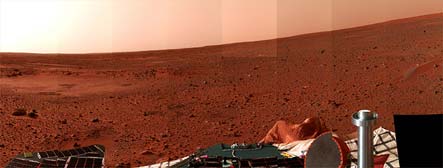|
| ||||||
| |
 | |
|
|
THE loss of seven astronauts when the space shuttle Columbia disintegrated on re-entering Earth’s atmosphere, almost a year ago, dealt a serious blow to Americans’ faith in NASA, the agency that designed, built and operates the shuttle. Since then, there have been two important reviews: the first, completed in August last year, looked at some of the agency’s inherent flaws. The results of the second, a root-and-branch examination of America’s space policy, are due to be announced this week. President George Bush’s officials say that on Wednesday January 14th he will reveal a bold new strategy for NASA: reportedly, this will include sending humans to Mars via the intermediate stage of a permanent lunar base.
Mr Bush no doubt hopes that launching an exciting, visionary project that invokes America’s pioneer spirit will boost his campaign to be re-elected in November’s presidential poll. Sceptics may also be forgiven for sensing a little déjà vu: in 1989, on the 20th anniversary of the first moon landing, Mr Bush’s father, then president, announced something rather similar. Cost estimates for the plan turned out to be so spectacularly expensive, in the region of $400 billion, that Congress quickly buried the idea.
According to Space.com, a news website, government insiders say the plan will call for Congress to approve an initial $800m of seed money as part of NASA’s 2005 budget request, followed by a 5% increase in its budget in subsequent years. Since this alone will not buy a lunar base—let alone put astronauts on Mars—it appears that the rest of the money will be found by severely pruning NASA’s current space activities. The shuttle programme is likely to be retired by the end of the decade, and it is rumoured that America’s involvement in the International Space Station (ISS) will be reduced a few years later. Many politicians see the space station as a costly failure. Together with the shuttle it consumes the lion’s share of NASA’s annual $15 billion budget.
Some scientists are already concerned that plans to focus on human exploration may put at risk valuable work that does not involve human spaceflight, such as the incredibly successful Hubble telescope and the search for life on other planets. In the past 30 years, NASA’s most notable and popular achievements have been in astronomy and in unmanned missions to other planets in the solar system. Any trimming of this work could actually reduce the public’s interest in, and approval of, NASA during the decade or more it will take to return to the moon.
The first thing Mr Bush’s proposals would require is the design of a new craft to take astronauts to the moon and then beyond—most likely, one based on the Apollo-era idea of a crew capsule riding on top of an expendable launch rocket. While it takes a mere three days to fly to the moon and the materials to build the lunar base could be sent ahead using cheap unmanned rockets, the onwards trip to Mars would take at least six months and thus the astronauts might have to survive away from Earth for several years. Besides being arduous, such a mission would be incredibly expensive. Enthusiasts currently put a Mars mission at as little as $20 billion; others suggest figures of $40 billion-$80 billion. Whatever figure NASA actually produces, however, Congress will be bitterly aware that the ISS project, despite being scaled back from its initial plans, ended up costing more than three times its original price tag. Sceptics on Capitol Hill may also recall that the ISS itself was also suggested as a stepping stone to Mars.
The plain fact is that, at this stage, nobody really knows how much a mission to Mars would cost, nor how long it would take to achieve. More than ten years, certainly, and as long as 30 years, say some. A one-off, “flag and footprint” style mission to the red planet might seem pointless to politicians—unless another country, such as China (which recently launched a man into space), threatened to get there first. Since Mr Bush’s grand vision may not be shared by the current Congress or future ones—or indeed future presidents—his grand announcement this week may not, in the end, amount to anything more than starry-eyed campaign rhetoric. Of course, only an incorrigible sceptic could possibly conclude that Mr Bush knows this perfectly well—and intends simply to let the whole thing fade away after it has helped him get re-elected.
Ultimately, if NASA is to succeed in human space exploration, it will have to increase its budget substantially, abandon much of its other, valuable work, or ideally find a way of successfully exploiting space commercially. Until now, NASA has been spectacularly unsuccessful in this ambition because it is not designed for this purpose. Any presidential vision ought, then, to include a way of eventually wrestling space activities out of the agency’s clutches and into the hands of the private sector.
| Copyright © 2004 The Economist Newspaper and The
Economist Group. All rights reserved. |